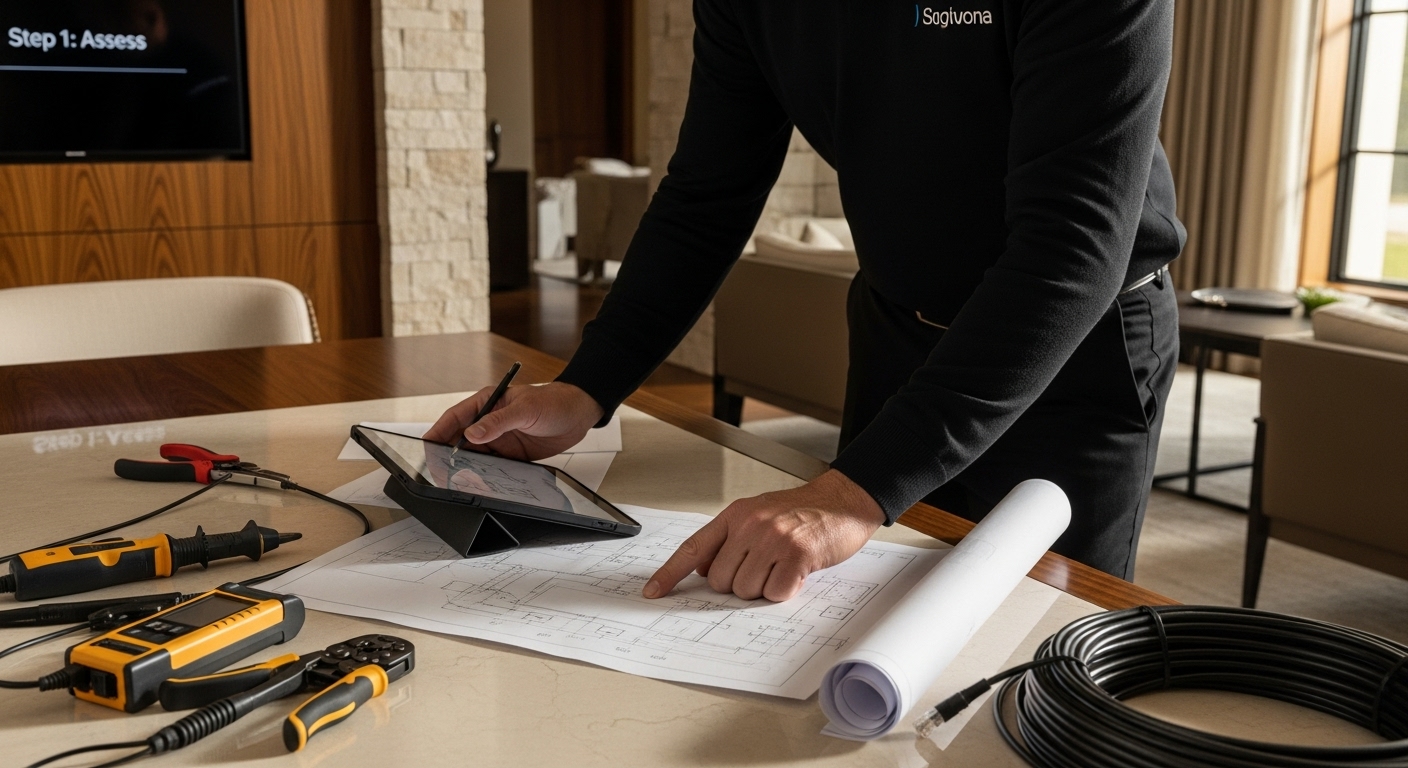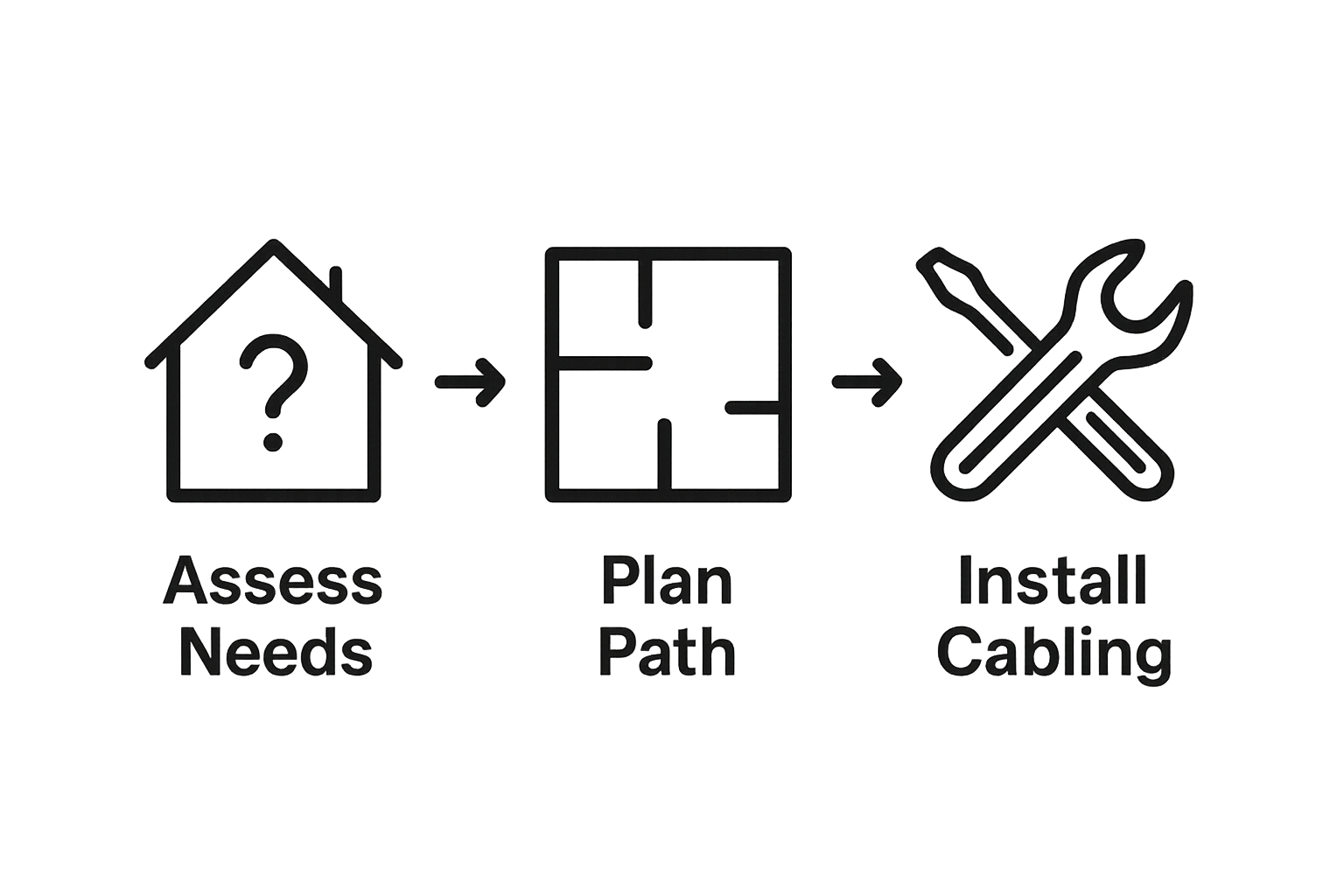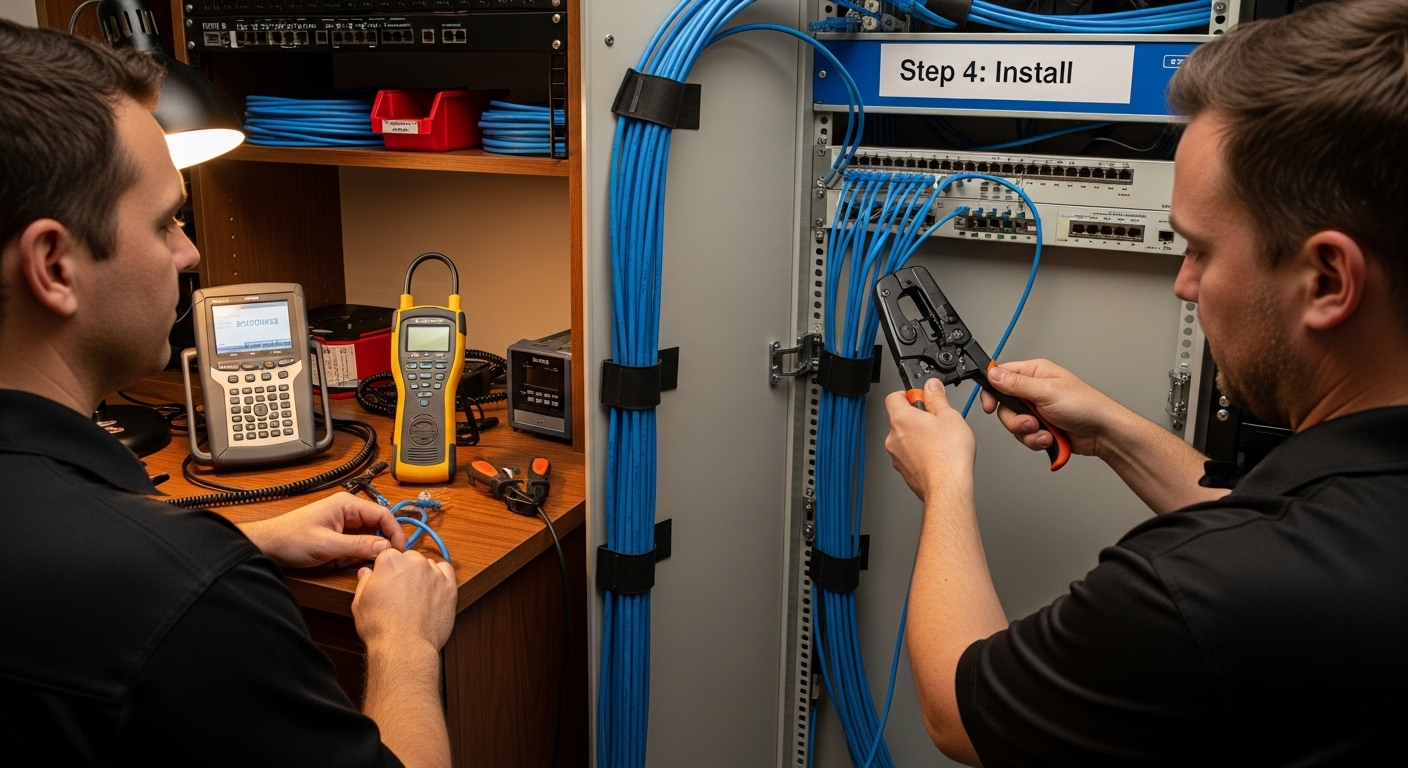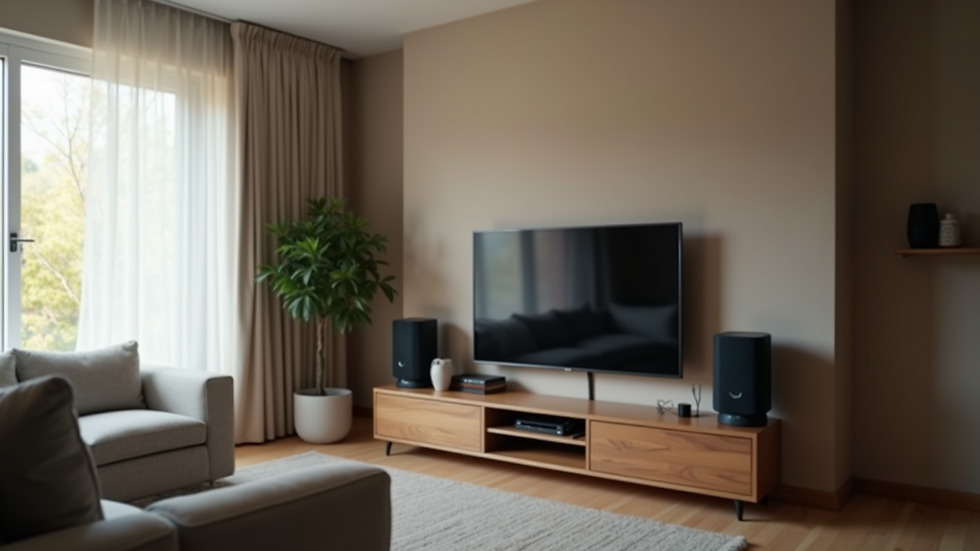Structured Cabling Installation Steps for Luxury Homes
- garygarihanjr
- Sep 26
- 10 min read

Building a bulletproof home network is turning into a must for luxury homeowners. Some residences now rely on over 60 connected devices working together, from smart fridges to 8K TVs and nonstop security cameras. Most people think WiFi alone can handle the load, no sweat. Wired cabling is actually what keeps high-tech homes running smooth, hidden in the walls and never letting you down when streaming or working from home really matters.
Table of Contents
Quick Summary
Key Point | Explanation |
1. Assess home network needs thoroughly | Evaluate current and future connectivity requirements to support all devices and advanced technologies in your luxury home. |
2. Plan cabling paths carefully | Design a strategic blueprint for cable layout to optimize performance, minimize interference, and allow for scalability. |
3. Invest in high-quality materials | Use premium components, like Category 6A or fiber optic cabling, to ensure reliability and minimize future complications. |
4. Execute precise installation techniques | Follow detailed protocols during cabling installation to guarantee optimal signal integrity and protect the infrastructure. |
5. Conduct thorough testing of connections | Validate the performance of all network connections to ensure they meet standards and support high-bandwidth activities effectively. |
Step 1: Assess Your Home Networking Needs
Structured cabling installation begins with a comprehensive assessment of your home’s networking requirements. This initial phase is critical for designing a robust, future-proof infrastructure that supports your luxury home’s technological ecosystem. Homeowners must carefully evaluate their current and anticipated connectivity needs to ensure the structured cabling system can handle advanced smart home technologies, high-bandwidth entertainment systems, and comprehensive home automation solutions.
The assessment process involves understanding the specific technological demands of your living space. Consider the total number of devices that will connect to your network, including smartphones, tablets, computers, smart home controllers, security systems, entertainment platforms, and emerging Internet of Things (IoT) devices. Modern luxury homes often feature multiple high-performance zones requiring dedicated network infrastructure, such as home theaters, professional workspaces, gaming areas, and integrated audio visual systems.
Explore our comprehensive guide on home networking essentials to gain deeper insights into creating a sophisticated home technology environment. When evaluating your networking needs, pay special attention to bandwidth requirements for 4K and 8K video streaming, professional video conferencing, cloud storage synchronization, and potential remote work capabilities. Professional installers recommend mapping out each room’s technological potential, understanding device locations, and anticipating future technology integration.
Key considerations during your network needs assessment should include:

Total square footage of your home
Number of simultaneous device connections
Bandwidth requirements for different activity zones
Potential future technology expansions
Successful structured cabling installation depends on thorough upfront planning. By meticulously documenting your current and projected networking requirements, you establish a solid foundation for a sophisticated, seamless home technology infrastructure that can adapt and grow with your evolving lifestyle and technological advancements.
Step 2: Plan the Cabling Path and Layout
After assessing your home networking needs, the next critical phase of structured cabling installation involves meticulously planning the cabling path and layout. This step transforms your initial network requirements into a strategic blueprint that ensures optimal signal performance, aesthetic integration, and future scalability. Proper cable routing is fundamental to creating a seamless technological infrastructure that remains invisible yet powerfully connected throughout your luxury home.
Learn more about structured cabling fundamentals to understand the intricate design process. Strategic cable path planning requires understanding your home’s architectural nuances, identifying potential interference zones, and selecting pathways that minimize signal degradation. Professional installers recommend creating a comprehensive mapping that considers wall cavities, ceiling spaces, potential conduit locations, and strategic distribution points that centralize network connectivity.
Your cabling layout must account for multiple critical considerations. Hidden infrastructure pathways like interior walls, dropped ceilings, and utility spaces provide optimal cable routing opportunities. Minimize cable length and avoid sharp bends to maintain signal integrity and performance. Consider future expansion by including additional slack in cable runs and designing flexible distribution points that can accommodate emerging technologies. Carefully document proposed cable routes, marking precise locations for network ports, telecommunications rooms, and connection interfaces.
Key planning elements include:
Identifying central network distribution hub locations
Mapping cable routes through least intrusive architectural spaces
Anticipating potential future technology integrations
Maintaining appropriate cable bend radius and length limitations
Successful cabling path planning requires a delicate balance between technical precision and architectural sensitivity. By creating a thoughtful, forward-looking cable infrastructure design, you establish a robust foundation for your home’s technological ecosystem that remains both powerful and elegantly concealed.
Step 3: Purchase Necessary Materials and Tools
With your network infrastructure carefully planned, selecting the right materials and tools becomes a critical phase in structured cabling installation for luxury homes. High-quality components are the foundation of a reliable, high-performance network that can support advanced technological ecosystems. Professional installers understand that investing in premium materials upfront prevents potential performance issues and costly future replacements.
Explore our comprehensive wiring installation services to understand the nuanced requirements of professional-grade network infrastructure. When purchasing materials, prioritize Category 6A or fiber optic cabling that supports high-bandwidth applications and future technological expansions. Select cables with superior shielding to minimize electromagnetic interference, especially in homes with complex electronic environments. Consider purchasing cables with plenum ratings for improved fire safety, particularly when routing through air handling spaces.
Your toolkit should encompass professional-grade equipment designed for precision installation. Essential tools include cable crimpers, wire strippers, cable testers, tone generators, punch-down tools, and specialized network installation kits. Invest in high-quality testing equipment to verify cable performance and signal integrity throughout the installation process. Professional-grade cable management accessories like cable ties, velcro wraps, patch panels, and cable organizers will help maintain a clean, organized network infrastructure that supports long-term system reliability.
Key materials to purchase include:
High-performance Category 6A or fiber optic network cables
Comprehensive cable testing and installation toolkit
Cable management and organization accessories
Patch panels and network distribution hardware
Careful material selection transforms your structured cabling project from a basic connectivity solution into a sophisticated, future-ready network infrastructure. By prioritizing quality components and professional-grade tools, you establish a robust technological foundation that seamlessly supports your luxury home’s advanced connectivity requirements.
Here is a table summarizing the essential materials and tools needed for structured cabling installation in a luxury home, including their main purposes.
Material/Tool | Description | Purpose |
Category 6A or Fiber Optic Cables | High-performance cabling for network connections | Support high-bandwidth and future expansion |
Cable Testing Kit | Professional-grade diagnostic equipment | Verify cable performance and integrity |
Cable Management Accessories | Ties, wraps, organizers | Maintain clean, organized cable layouts |
Patch Panels & Distribution Hardware | Network distribution components | Centralize and organize network connections |
Cable Crimpers and Strippers | Precision installation tools | Prepare and terminate cables effectively |
Punch-down Tool | Tool for connecting cables to patch panels/outlets | Ensure secure, consistent cable connections |
Tone Generator & Tester | Device locator and basic signal checker | Identify and test individual cable runs |
Step 4: Install the Cabling Infrastructure
Installing the cabling infrastructure represents the most critical and intricate phase of your structured cabling project. Precision and attention to detail are paramount during this transformative stage where your carefully planned network design transitions from conceptual blueprint to physical reality. Professional installers approach this step with methodical precision, understanding that each cable run and connection point determines the long-term performance of your home’s technological ecosystem.
Learn more about our comprehensive wiring installation process to understand the nuanced techniques professionals employ. Begin by preparing your work environment, ensuring clean pathways and protecting existing architectural elements during installation. Carefully route cables through predetermined paths, maintaining minimum bend radius requirements and avoiding potential sources of electromagnetic interference. Use specialized fish tape or cable pulling tools to navigate cables through tight wall cavities, ceiling spaces, and conduit channels without damaging the cable’s structural integrity.
Professional installation requires meticulous documentation and testing at each stage. As you run cables, systematically label each cable run with unique identifiers, recording precise routing information and connection points. Utilize punch-down tools to create secure connections at patch panels and wall outlets, ensuring consistent performance across your network infrastructure. Maintain appropriate cable tension and avoid excessive stress that could compromise signal transmission. After completing the physical installation, conduct comprehensive signal testing using advanced network diagnostic tools to verify performance, checking for signal strength, potential interference, and overall network reliability.
Key installation considerations include:
Maintaining proper cable bend radius and tension
Protecting cables from potential physical damage
Documenting precise cable routing and connection points
Conducting thorough signal performance testing
Successful cabling infrastructure installation transforms your luxury home’s technological potential, creating a robust, invisible network foundation that supports current and future connectivity requirements with exceptional reliability and performance.

Step 5: Configure Network Devices and Connect
Configuring network devices represents the critical moment where your meticulously planned structured cabling infrastructure transforms into a functional, intelligent home technology ecosystem. This phase demands precision and strategic planning to ensure seamless connectivity and optimal performance across all network-connected systems. Professional installers approach device configuration as a comprehensive process that goes beyond simple plug-and-play connections.
Explore our comprehensive home networking best practices to understand the nuanced approach to network device integration. Begin by strategically positioning your primary network equipment, such as routers, switches, and network management devices, in the central distribution hub identified during earlier planning stages. Carefully configure network settings, establishing secure administrative credentials and implementing robust security protocols. This includes setting unique passwords, enabling advanced encryption standards, and configuring network segmentation to protect different technological zones within your home.
Network device configuration extends beyond basic connectivity. Implement advanced features like Quality of Service (QoS) settings to prioritize critical network traffic, such as video conferencing, streaming, and home security systems. Create separate virtual local area networks (VLANs) for different device categories, ensuring enhanced security and performance optimization. Systematically connect and configure each network port, verifying signal strength and performance through comprehensive diagnostic testing. Pay special attention to potential interference sources and adjust device placement or settings to maintain optimal signal transmission across your luxury home’s technological infrastructure.
Key configuration considerations include:
Establishing secure network administrative credentials
Implementing advanced encryption and network segmentation
Configuring Quality of Service (QoS) settings
Creating separate network zones for different device categories
Successful network device configuration translates your structured cabling investment into a powerful, intelligent connectivity ecosystem that supports your luxury home’s technological requirements with exceptional reliability and performance.
Step 6: Test and Verify Connections for Quality
Testing and verifying network connections represents the critical final validation stage of your structured cabling installation, where theoretical design meets practical performance. Comprehensive testing ensures that your sophisticated home network delivers the exceptional reliability and speed promised during initial planning. Professional installers approach this phase with methodical precision, understanding that seemingly minor connection issues can dramatically impact overall network performance.
Learn more about smart home troubleshooting techniques to understand advanced diagnostic approaches. Utilize professional-grade cable testing equipment capable of performing comprehensive diagnostics on each network connection. Conduct thorough signal integrity tests that measure critical parameters including wire map, length, insertion loss, near-end crosstalk, return loss, and propagation delay. These sophisticated tests reveal potential installation imperfections that could compromise network performance, allowing for immediate remediation before final system activation.
Carry out systematic testing across multiple dimensions of your network infrastructure. Begin with individual cable run verifications, using specialized network testers to confirm each connection meets industry standards for Category 6A or fiber optic cabling. Progressively expand testing to evaluate overall network performance, checking bandwidth capabilities, signal-to-noise ratios, and potential interference sources. Simulate real-world network scenarios by conducting simultaneous high-bandwidth activities across multiple devices, ensuring your structured cabling can support the demanding technological ecosystem of a luxury home.
Key testing and verification steps include:
Performing comprehensive cable diagnostics on each network connection
Measuring signal integrity across multiple performance parameters
Simulating high-bandwidth network scenarios
Documenting and addressing any detected performance limitations
Successful network connection testing transforms your structured cabling from a theoretical design into a robust, high-performance technological foundation. By meticulously validating each connection, you ensure your luxury home’s network infrastructure delivers exceptional reliability, speed, and future-ready connectivity.
Take the Stress Out of Structured Cabling for Your Luxury Home
Are you feeling overwhelmed by the complexity of structured cabling installation? Planning the perfect network and choosing premium materials can leave even the most detail-oriented homeowners frustrated. The stakes are high. Every step from assessing smart device demands to mapping cable paths can impact security and performance in your luxury home. You deserve a seamless experience, not constant troubleshooting or subpar connections. Discover how our professional team at Techology Experts specializes in transforming your structured cabling vision into a flawless reality.

Why risk costly mistakes or missed future upgrades? With proven expertise in wiring installation and an eye for elegant, future-proof solutions, we handle every detail so you can enjoy a powerful, connected environment. Secure your peace of mind and elevate your home’s technology foundation today. Visit Techology Experts now to request a personalized consultation and ensure your home is equipped for today’s innovation and tomorrow’s possibilities.
Frequently Asked Questions
What is structured cabling and why is it important for luxury homes?
Structured cabling is a standardized approach to building a telecommunications infrastructure that includes a variety of cabling types, network ports, and devices. It is important for luxury homes because it supports high-bandwidth applications, ensures efficient connectivity for multiple devices, and offers future scalability for new technologies and smart home features.
How do I assess my home networking needs before structured cabling installation?
To assess your home networking needs, consider factors such as the total square footage of your home, the number of devices that will be connected, and the bandwidth requirements for different areas like home theaters, workspaces, or gaming zones. Also, anticipate future technology expansions to ensure your infrastructure can support evolving connectivity demands.
What types of cables should I use for structured cabling in a luxury home?
It’s recommended to use Category 6A cables or fiber optic cabling for structured cabling in luxury homes. These options support high-bandwidth applications and offer superior shielding to minimize electromagnetic interference, ensuring reliable performance for various smart home technologies.
How can I ensure the quality and reliability of my structured cabling installation?
To ensure quality and reliability, conduct comprehensive testing after the installation process. Use professional-grade cable testing equipment to measure key parameters such as signal integrity, bandwidth capabilities, and potential interference. Document and address any performance limitations to maintain a robust network infrastructure.
Recommended

Comments